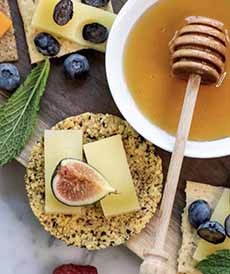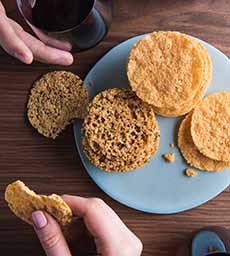Enjoy Cheese More By Pairing Cheeses With Sweet Condiments
|
We recently dined at a wonderfully creative new restaurant in New York City, Frevo. A cheese course is typically served before dessert, or instead of it. Quite a few connoisseurs prefer to end dinner with cheese instead of something sweet. Our cheese course consisted of Comte cheese, shaved into pappardelle-size ribbons (fettuccine size works, too), drizzled with honey and topped with a frico of Comte. Alas, we don’t have a photo of the ribbons of cheese drizzled with honey. They’re hidden under the fricos in photo #1. You can use any cheese that can be grated into ribbons. These are typically any semi-hard cheese: Cheddar, Colby, Comte, Gouda, Manchego, Provolone, and others†. If you enjoy fine cheese, don’t wait until your next dinner party. Start pairing sweet condiments with cheese ASAP. In the words of Nike, just do it! You don’t have to grate it or top it with a frico. A frico (FREE-co) is a delicate, lacy baked cheese thin that originated in Italy*. The only ingredient in frico is cheese unless you want to add herbs or spices. The grated cheese is scooped onto a cookie sheet and baked until crisp. You can bake your own, with your cheese of choice and a grater and an oven. Cheese is the only ingredient unless you want to add herbs or spices. Or, purchase them from Parm Crisps, plain or with different flavors, including Jalapeño and Sesame (photo #5). But the reason we created this article is not for the frico, but for what Frevo did with it. It was perhaps the most delightful cheese course we’ve ever had. They drizzled honey over it, and added a side of honey mousse (photo #1), leading to today’s tip: The idea is pretty conventional outside of the U.S., although some cheeseboard ingredient lists recommend it. And in the American South, hosts have long topped a block of cream cheese with preserves or pepper jelly. So we begin with a selection of sweet condiments that you can serve with your next cheese plate. If these seem bizarre to you, they are time-honored pairings among cheesemongers and connoisseurs. Try it before you judge it! Why do they work? The flavor combinations are salty plus sweet, mild plus savory, sharp plus fruity. |
|
|
|
>>> DISCOVER MORE ABOUT CHEESE IN THE NIBBLE’S CHEESE GLOSSARY <<< _______________ *In the Italian region of Friuli, frico refers to a dish of heated cheese and other ingredients, such as potatoes. It is baked in a round pan, is soft, and served in slices (like pizza). There is also a thin, crunchy version, similar to the frico described above, which is used as an appetizer or a garnish. While the first version has been made for centuries,the crunchy version is more recent. The cheeses in the Semi-Hard category include a broad range of textures, from semi-firm to very firm; and from cheeses that are only weeks old to those aged up to several months or more. Because these cheeses contain less moisture than the soft and soft-ripened types, they hold their shape much better. Examples include young Asiago, Cheddar, Colby, Edam, Fontinella, aged Gouda, Manchego, Provolone and Queso Blanco. The difference between semi-hard and semi-soft cheese is one of moisture: Semi-soft cheese contains more than 45% water, while semi-hard cheeses contain 30% to 45%. A cheese can start as semi-soft, then move to semi-hard via aging, which evaporates the moisture. CHECK OUT WHAT’S HAPPENING ON OUR HOME PAGE, THENIBBLE.COM. |
||







